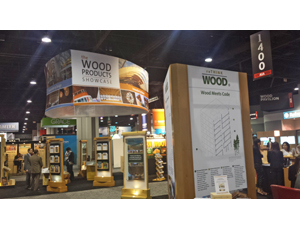
The American Wood Council, on a roll after it succeeded in getting new provisions into the 2015 International Building Code that allow heavy-timber structure within exterior walls, is proposing even bigger changes for the 2018 IBC, currently under development. The proposal would allow two- or three-hour-rated heavy timber to “safely serve in diverse structures” as tall as 100 ft, said Paul D. Coats, Southeast regional manager for the American Wood Council (AWC), at the 2015 American Institute of Architects Convention, held on May 14-16 in Atlanta.
AWC has put forth two proposals: One would allow a maximum nine-story residential building at no more than 100 ft above grade. The other would allow a three-hour fire-rated podium made of heavy timber that could support a wood frame above it.
Currently, the IBC permits up to five or six stories of heavy-wood structure, depending on the building use. Multifamily residential structures can be built up to five stories. Commercial buildings can be six stories if fully sprinklered.
To date, the general code development committee of the International Code Council, which develops the IBC, recommended against approval of the proposals. Coats is not discouraged, however. "We expected this," he says. "It's a new concept."
“Our efforts are designed to educate the building official and fire service community about the potential and feasibility of mass timber tall structures,” said Coats. “This code-change cycle, we opened that discussion.”
For the proposal to be adopted, this fall, two-thirds of the entire ICC membership must vote in favor. Though the jury is still out, Coats says he does not expect success in this code cycle. Rather, he thinks that, after some fire testing, there is a better chance of approval for the 2021 code.
The primary change in the 2015 IBC allows use of cross-laminated timber in exterior walls of Type IV—heavy timber—construction. Previously, in Type IV construction, only noncombustible materials could be used in the exterior walls. CLT was allowed only in the interior.
Most states likely will adopt the 2015 IBC in the next two to three years. Seattle already has adopted it.
Also at the convention, which had nearly 18,000 registrants, the American Institute of Architects released its first model document to support teams that join to pursue a project. The Standard Form of Teaming Agreement Between Team Manager and Team Member for the Purpose of Responding to a Solicitation and Pursuing a Project, C102™–2015, is intended to allow multiple or cross-disciplinary parties to form a team to provide services necessary to submit a proposal, in response to a solicitation, for a "shared opportunity project," says AIA.
C102-2015 is not limited to use within a single project delivery method and can be used for responses to requests for proposals, design competitions, design-build competitions or public-private partnerships. Under the document, one party serves as the team manager, which would enter into separate teaming agreements with each of the team members.
If the team is awarded the project, the team manager would contract directly with the owner. Each team member then would have a separate agreement with the team manager for services or work to be performed on the project, based on agreed-upon conditions. When the team manager enters into an agreement with the owner for the project, C102 terminates and the agreement between the team manager and team member becomes effective.
In addition, at the convention, Jeffrey W. Ouellete, vice chairman of the National BIM Standard-United States Version 3 project committee, announced that the expanded NBIMS-US would be released in early June. The new version effectively doubles the size of the standard. It includes 12 new reference standards, eight of which are OmniClass tables; six new information exchange documents, including a new version of COBie-Version 2.4; five new practice guidelines; and a new glossary.



Post a comment to this article
Report Abusive Comment